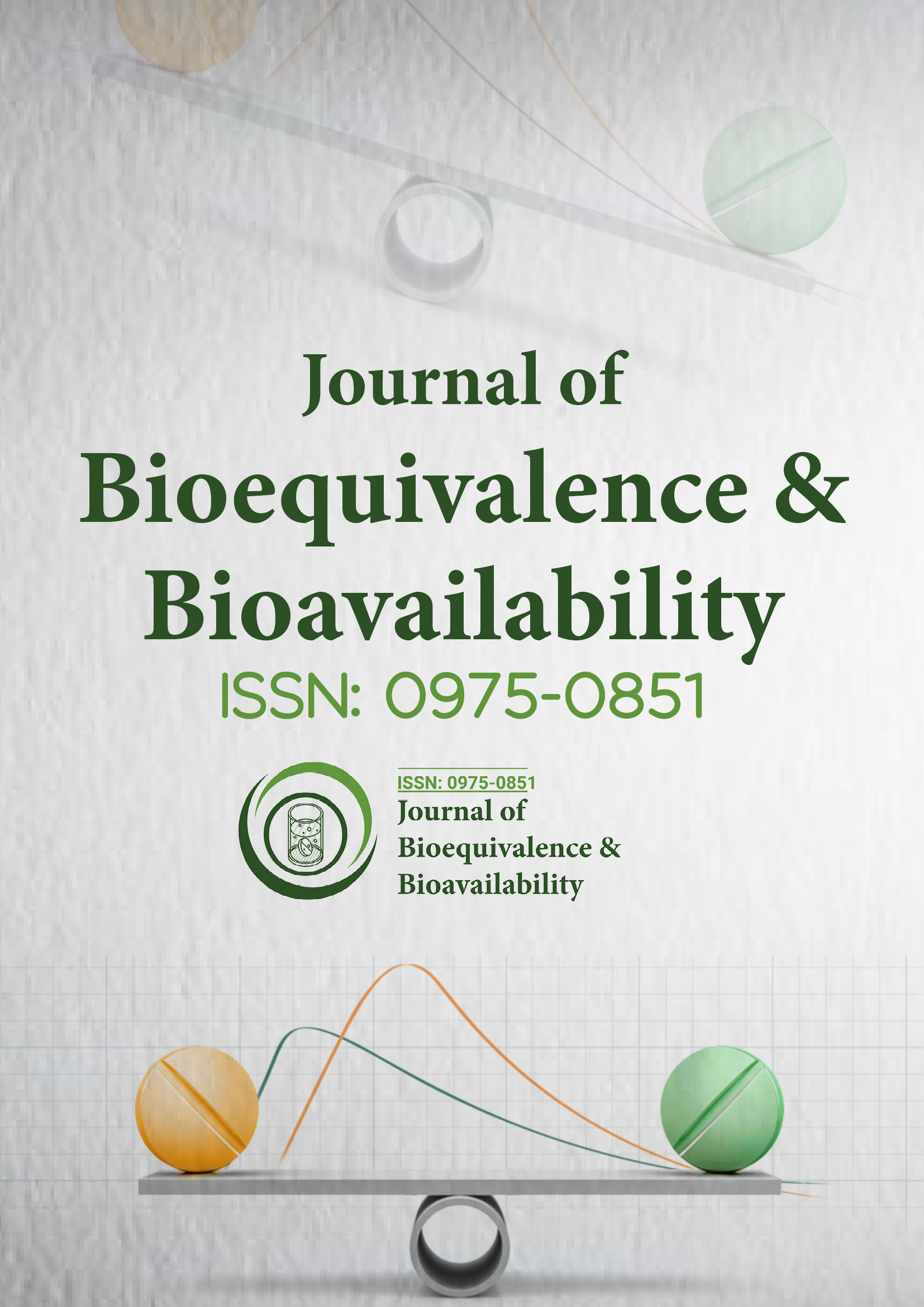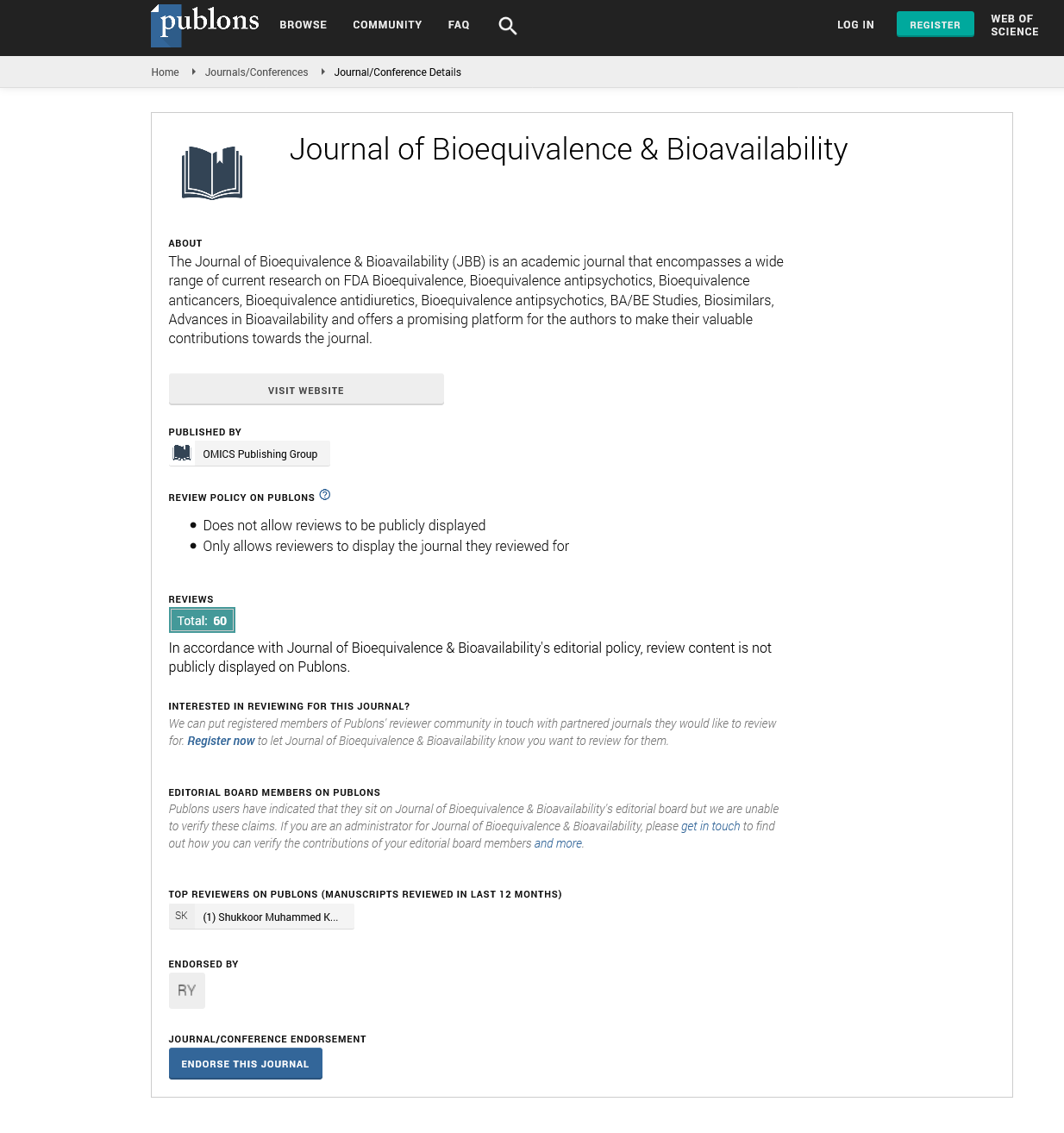Indexed In
- Academic Journals Database
- Open J Gate
- Genamics JournalSeek
- Academic Keys
- JournalTOCs
- China National Knowledge Infrastructure (CNKI)
- CiteFactor
- Scimago
- Ulrich's Periodicals Directory
- Electronic Journals Library
- RefSeek
- Hamdard University
- EBSCO A-Z
- OCLC- WorldCat
- SWB online catalog
- Virtual Library of Biology (vifabio)
- Publons
- MIAR
- University Grants Commission
- Geneva Foundation for Medical Education and Research
- Euro Pub
- Google Scholar
Useful Links
Share This Page
Journal Flyer

Open Access Journals
- Agri and Aquaculture
- Biochemistry
- Bioinformatics & Systems Biology
- Business & Management
- Chemistry
- Clinical Sciences
- Engineering
- Food & Nutrition
- General Science
- Genetics & Molecular Biology
- Immunology & Microbiology
- Medical Sciences
- Neuroscience & Psychology
- Nursing & Health Care
- Pharmaceutical Sciences
Opinion - (2025) Volume 17, Issue 3
The Scientific and Regulatory Basis of Therapeutic Equivalence
Humberto Gomes*Received: 28-May-2025, Manuscript No. JBB-25-30142; Editor assigned: 30-May-2025, Pre QC No. JBB-25-30142 (PQ); Reviewed: 13-Jun-2025, QC No. JBB-25-30142; Revised: 20-Jun-2025, Manuscript No. JBB-25-30142 (R); Published: 29-Jun-2025, DOI: 10.35248/0975-0851.25.17.642
Abstract
Description
Therapeutic equivalence refers to the situation where two pharmaceutical products produce the same clinical effect and safety profile when administered under identical conditions. It is a cornerstone concept in modern pharmacology and drug regulation, ensuring that patients receive the same therapeutic outcomes whether they use a brand-name or generic drug. Establishing therapeutic equivalence supports accessibility, affordability, and reliability in healthcare systems worldwide [1].
To be considered therapeutically equivalent, two products must be pharmaceutically equivalent and bioequivalent. Pharmaceutical equivalence means that the products contain the same active ingredient, dosage form, strength, and route of administration. Bioequivalence refers to the absence of significant differences in the rate and extent of absorption of the active ingredient, as determined by pharmacokinetic parameters such as peak plasma concentration (C_max) and Area under the Curve (AUC). When both criteria are satisfied, therapeutic equivalence can be reasonably inferred without requiring extensive clinical trials.
Regulatory authorities such as the U.S. Food and Drug Administration (FDA), European Medicines Agency (EMA), and other national agencies have established rigorous frameworks for determining therapeutic equivalence. Generic drugs, for instance, must demonstrate bioequivalence to their branded counterparts through well-designed pharmacokinetic studies in healthy volunteers. These studies ensure that the generic version delivers the active ingredient to the bloodstream at the same rate and extent as the reference product [2-6]. This scientific approach minimizes the need for repeated clinical testing while maintaining therapeutic consistency.
While bioequivalence forms the foundation for therapeutic equivalence, other factors such as excipients, manufacturing processes, and formulation stability can influence therapeutic outcomes. Differences in inactive ingredients can alter drug release, absorption, or tolerability, particularly in modified-release formulations or Narrow Therapeutic Index (NTI) drugs. For NTI drugs such as warfarin, digoxin, or phenytoin, even minor variations in drug exposure can lead to therapeutic failure or toxicity. Hence, regulatory agencies require tighter bioequivalence limits and additional evaluation for such products to ensure safety and efficacy [7].
Therapeutic equivalence extends beyond pharmacokinetics into pharmacodynamics and clinical response. Although bioequivalence implies similar exposure, factors like receptor sensitivity, active metabolites, and individual variability can influence therapeutic outcomes. Therefore, post-marketing surveillance and pharmacovigilance play important roles in confirming clinical equivalence after approval. Adverse event monitoring, real-world data analysis, and patient feedback contribute to verifying that generic and branded drugs perform equivalently in diverse populations [8].
Therapeutic equivalence also holds significance in global healthcare access. Generic substitution policies rely on this principle to promote cost-effective therapy without compromising quality. By encouraging the use of therapeutically equivalent generics, healthcare systems can reduce expenditure and expand access to essential medicines. However, maintaining public trust requires consistent quality assurance, transparency in bioequivalence testing, and education among healthcare professionals and patients about the scientific validity of generic substitution [9-10].
In conclusion, therapeutic equivalence is a fundamental principle ensuring that different formulations of the same drug provide equivalent clinical outcomes. It bridges pharmaceutical science, clinical pharmacology, and regulatory policy to safeguard patient health and promote accessibility. Through stringent bioequivalence testing, ongoing surveillance, and advancements in modelling and analytics, therapeutic equivalence continues to support the safe and effective interchangeability of drugs in modern medicine. Its role is indispensable in ensuring both the scientific integrity and the social responsibility of global healthcare systems.
References
- Aldern KA, Ciesla SL, Winegarden KL, Hostetler KY. Increased antiviral activity of 1-O-hexadecyloxypropyl-[2-14C] cidofovir in MRC-5 human lung fibroblasts is explained by unique cellular uptake and metabolism. Mol Pharmacol. 2003;63(3):678-681.
[Crossref] [Google Scholar] [PubMed]
- Cihlar T, Chen MS. Identification of enzymes catalyzing two-step phosphorylation of cidofovir and the effect of cytomegalovirus infection on their activities in host cells. Mol Pharmacol. 1996;50(6):1502-1510.
[Crossref] [Google Scholar] [PubMed]
- Hostetler KY. Alkoxyalkyl prodrugs of acyclic nucleoside phosphonates enhance oral antiviral activity and reduce toxicity: Current state of the art. Antiviral Res. 2009;82(2):84-98.
[Crossref] [Google Scholar] [PubMed]
- Schuirmann DJ. A comparison of the two one-sided tests procedure and the power approach for assessing the equivalence of average bioavailability. J Pharmacokinet Biopharm. 1987;15:657-680.
[Crossref] [Google Scholar] [PubMed]
- Lanier R, Trost L, Tippin T, Lampert B, Robertson A, Foster S, et al. Development of CMX001 for the treatment of poxvirus infections. Viruses. 2010;2(12):2740.
[Crossref] [Google Scholar] [PubMed]
- Chan-Tack K, Harrington P, Bensman T, Choi SY, Donaldson E, O'Rear J, et al. Benefit-risk assessment for brincidofovir for the treatment of smallpox: US Food and Drug Administration's Evaluation. Antiviral research. 2021;195:105182.
[Crossref] [Google Scholar] [PubMed]
- Olson VA, Smith SK, Foster S, Li Y, Lanier ER, et al. In vitro efficacy of brincidofovir against variola virus. Antimicrob Agents Chemother. 2014;58(9):5570-5571.
[Crossref] [Google Scholar] [PubMed]
- Florescu DF, Keck MA. Development of CMX001 (Brincidofovir) for the treatment of serious diseases or conditions caused by dsDNA viruses. Expert Rev Anti Infect Ther. 2014;12(10):1171-1178.
[Crossref] [Google Scholar] [PubMed]
- Tippin TK, Morrison ME, Brundage TM, Momméja-Marin H. Brincidofovir is not a substrate for the human organic anion transporter 1: A mechanistic explanation for the lack of nephrotoxicity observed in clinical studies. Ther Drug Monit. 2016;38(6):777-786.
[Crossref] [Google Scholar] [PubMed]
- Marty FM, Winston DJ, Chemaly RF, Mullane KM, Shore TB, Papanicolaou GA, et al. A randomized, double-blind, placebo-controlled phase 3 trial of oral brincidofovir for cytomegalovirus prophylaxis in allogeneic hematopoietic cell transplantation. Biol Blood Marrow Transplant. 2019;25(2):369-381.
[Crossref] [Google Scholar] [PubMed]
Citation: Gomes H (2025). The Scientific and Regulatory Basis of Therapeutic Equivalence. J Bioequiv Availab. 17:642.
Copyright: © 2025 Gomes H. This is an open-access article distributed under the terms of the Creative Commons Attribution License, which permits unrestricted use, distribution, and reproduction in any medium, provided the original author and source are credited.

